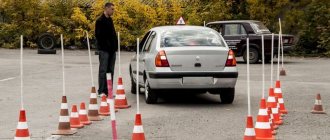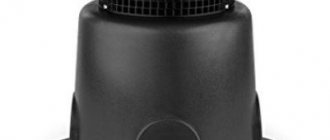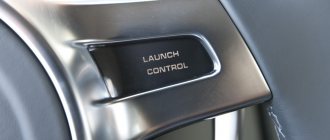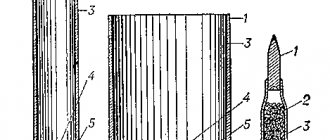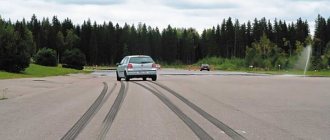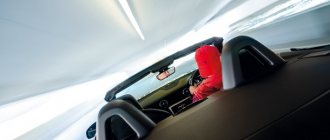Every beginner in a driving school is taught to maintain a safe distance - the distance to the nearest vehicle, which allows you to avoid a collision in case of sudden braking or lateral maneuver. However, if you ask even experienced instructors about this term, you will hear “mixed” opinions. Moreover, some will count in meters, others – in seconds. The fact is that the traffic rules do not contain specific instructions on this matter, but only the concept of “effective distance” between cars. Therefore, in fact, drivers have to independently determine this value and know what this parameter is depending on many factors. After all, in this matter it is better not to count on chance...
Statistics.
In terms of their danger to life, passenger cars occupy second position after motorcycles. Moreover, in Russia, cases of collisions due to an incorrectly chosen distance are not decreasing - depending on the year, this figure fluctuates between 35-50% of the total number of accidents.
In the city
Motorists generally believe that the safe distance between cars in meters is equal to half the speed. For example, when a car is driving in traffic on a dry asphalt surface at a speed of 60 km/h, then the car in front should be approximately 30 m away. However, in urban conditions, it is sometimes even half impossible to meet this condition. By the way, inexperienced drivers try to create a “clearance” of 10-15 m between a neighboring vehicle, and make a serious mistake. After all, many more experienced car owners in such a situation “wedge themselves” between cars, forcing the “teapot” to be nervous and make mistakes. Therefore, the effective distance on a city road should be 2/3 of the vehicle body. When applied to passenger cars, this is 3-4 meters.
At crossroads.
When a group of cars suddenly starts at an intersection, the distance between them is reduced to just a few meters, or even less. Of course, drivers hope that the leader in front of them will not brake suddenly. However, this is only a small part of the problems that can be encountered at traffic lights. By moving closely behind another car, the driver automatically deprives himself of freedom of action:
the view of the road is narrowed;
most maneuvers and acceleration are unacceptable;
if the leader has stopped, you won’t be able to go around him, and you won’t be able to go back either, since there are other cars backing up behind him;
emergency braking becomes impossible, since there is no stopping route as such.
Accordingly, at a traffic light the safe distance should be such that it is possible to quickly drive around a stopped car without engaging reverse. There is nothing extraordinary in this recommendation: after all, any road user can simply stall at an intersection. And just a few meters of reserve will allow you to quickly change lanes and avoid an accident.
Therefore, when stopping in front of a busy intersection, you need to maintain a distance of 2-3 meters. By the way, this is enough so that in the event of a rear impact, the car does not hit the neighbor in front and cars in the other lane.
RECOMMENDATION.
In bad weather or in difficult urban areas, the safe traffic distance should be less than the visibility distance. This rule applies to crossing roadways with poor visibility, driving along narrow streets, and maneuvering on closed turns.
In traffic jams
The effective distance is considered to be approximately 2 meters - this is enough to change lanes. In addition, this footage does not allow other car drivers to “get in” between two cars, and also reduces the risk of sudden maneuvers.
In parking lots
There is no clear safe distance, it all depends on the specific situation. The main rule is that the lateral distance allows you to get out of the car without hitting the neighbors with the door. If you parked behind another car, then you need to “by eye” calculate the distance that will allow you to leave the parking lot if another car parks closely behind you.
Fines for non-compliance with distance
Driving not in accordance with the instructions of sign 3.16 is considered an administrative violation. The fine is imposed in amounts up to 1,500 rubles.
Repeated “crime” under the Code of Administrative Offenses entails an increase in sanctions to 3,000 rubles. And those who still haven’t understood the traffic rules risk losing their driver’s license.
Article 12.15 of the Code of Administrative Offenses presupposes similar actions against a motorist who has violated clause 9.10. Any maneuver made while driving along the roadway can be recorded on a video recorder or surveillance cameras.
The effective interval is chosen by the driver himself. According to Traffic Rules 9.10, it must be installed in such a way as to avoid a collision.
Recommended distances in an urban environment at a speed of 60 km/h are 3-4 meters, on the highway, when accelerating to 80 km/h - 15-20 meters.
All drivers must comply with these postulates to organize accident-free traffic. Drive according to traffic rules!
What signs show the main road according to the traffic rules, the article says: the main road according to the traffic rules. How cameras for recording traffic violations work, see the page.
Find out about traffic violations under a STOP sign from this information.
We invite you to familiarize yourself with the Penalty for alimony: its calculation and grounds for calculation
Driving not in accordance with the instructions of sign 3.16 is considered an administrative violation. The fine is imposed in amounts up to 1,500 rubles.
Article 12.15 of the Code of Administrative Offenses presupposes similar actions against a motorist who has violated clause 9.10. Any maneuver made while driving along the roadway can be recorded on a video recorder or surveillance cameras.
What signs show the main road in traffic regulations, the article says:
main road according to traffic regulations
.
How cameras for recording traffic violations work, see the page.
Find out about traffic violations under a STOP sign from this information.
In the country
Unlike urban conditions, where it is impossible to control the actions of other drivers, on the highway you can independently do everything in your power to avoid creating emergency situations. Moreover, you need to remember that a safe distance on roads with high speed limits is not just the distance from the bumper to the leading car. It should be taken into account that if the neighbor in front has an open hatch, hole, or deep puddle in his path, he will have to move sideways. And you must always be prepared for this.
The already mentioned rule applies here: the movement speed is divided by 2, and the number of “safe” distance meters is obtained. However, there is a list of objective requirements when the effective distance should be increased due to weather conditions - when driving at night, on asphalt concrete surfaces, snowy, icy and wet roads. In addition, a safe distance also depends on subjective factors:
driving at the end of a line of cars numbering more than 5 vehicles;
driving on poor-quality road surfaces;
the driver of the front car sharply increased the speed;
deterioration of visibility - unexpected obstacles appeared on the road, rain quickly turned into snowfall, etc.;
the vehicle in front is driven by a student or inexperienced driver.
What is the distance between cars according to traffic rules in meters?
Everything related to road traffic is aimed at maintaining safety for its participants. This is how the distance between cars is established according to traffic rules in paragraph 9.10:
The driver must maintain such a distance from the vehicle in front that would allow him to avoid a collision, as well as the necessary lateral interval to ensure traffic safety.
That is, the Rules do not prescribe specific values for these distances in meters . After all, they depend on many factors:
- technical condition and characteristics of the vehicle;
- speeds, including those of neighboring vehicles;
- quality and other features of the road surface;
- traffic density;
- weather conditions, visibility;
- time of day;
- individual qualities of drivers (reaction speed, experience, etc.);
- other circumstances that may arise in a particular case.
Application of the minimum distance limit sign
As a rule, it is installed on short sections of highways with high traffic flow, before sharp descents or sharp turns. It prohibits reducing the distance to the meters indicated on the sign - 50 m, 70 m, etc. However, you can increase the safe distance.
The coverage area of sign 3.16 begins from the place where it is installed and ends at the nearest intersection, at the beginning of populated areas and at the end of cities and towns. In addition, his ban is canceled after passing the “End of all restrictions zone” sign.
The concept of distance between cars
The traffic rules state that the driver is required to maintain a distance from cars moving in front and to the side.
The driver must be able not only to determine the required distance, but also be able to predict such contingencies as an emergency stop for the vehicle in front.
What factors influence the size of the distance?
Various factors influence the determination of the required distance:
- Condition of the road surface (presence of holes and cracks, gravel or asphalt surface);
- Speed limit on the highway;
- Driving experience (experienced drivers can identify a newcomer on the road);
- The quality of the car, its characteristics;
- Weather;
- Illumination.
As you can see, the driver needs to take into account many subtleties during the trip. At first glance, this seems difficult, but in fact, with experience comes the ability to assess and predict the situation on the road.
Advice from driving instructors for beginners
Private driving instructors, whose contact details are posted on, have developed their own “code” of safe driving over many years of working with inexperienced drivers. For example, they advise when driving on a road with limited visibility to increase the distance by 2 times compared to that recommended by traffic regulations. Compliance with this rule allows you to perform emergency maneuvers (braking, detour) without consequences for health and the vehicle.
In addition, when a novice driver is driving a passenger car carrying a heavy load, the safe distance should also be increased by about 1.5 times. This precaution is dictated by the fact that the braking distance of the car also increases by the specified amount.
TEST: TEST YOURSELF!
How do you know if the effective distance is correct?
The main indicator is the number of brakes performed by the driver. Less is better! Correctly chosen distance to other cars significantly increases road safety.
Braking distances
There are calculators on the Internet that allow you to calculate the braking distance for vehicles of different categories.
You can calculate it yourself using the formula: S = Kt*V² /254 Ks.
- S is the braking distance in meters.
- Kt - for a passenger car = 1, for a truck = 1.4 and higher.
- V is the speed at the beginning of braking.
- Kc determines the degree of adhesion of tires to the road surface. Kc = 0.7 when the asphalt is dry; Kc = 0.1 during icy conditions.
Article on the topic: Rating of the best GSM alarms
In the new edition of the traffic rules, highway owners are given the right to allow travel on sections of toll roads at a speed of 130 km/h. Let's calculate the braking distance for a passenger car.
S = 1*130*130 /254*0.7=95 m. Add a distance of 40 m. Approximately how much the car will travel seconds before braking begins (driver reaction time and brake application). We get that the distance on the road when driving at a speed of 130 km/h should be at least 149 m. Maintaining such a distance is guaranteed to save you from problems on the road.
Urban conditions
As before, the largest number of collisions are recorded in cities. At a speed of 60 km/h, the safe distance should be 15 - 17 meters. But maintaining such a distance in the city often turns out to be impossible (reasons: traffic congestion, the need to quickly change lanes at an intersection). In addition, drivers often use a traffic gap of even 10 meters to change lanes on a multi-lane road. To avoid an emergency, it is recommended to reduce the distance. For example, if traffic flows at a speed of less than 60 km/h, the interval between cars can be reduced to 4 - 5 meters.
Methods for determining distance
There are tricks to help you quickly find your bearings while driving. The first of them is dividing the speed of movement in half. This method is effective when moving on dry road surfaces and is more suitable for driving on the highway. To determine a safe distance, just look at the speedometer needle. The value seen is divided in half. In other words, if the vehicle speed is 80 km/h, there must be at least 40 m remaining to the car ahead.
If it rains or the asphalt is covered with a layer of ice, such calculations become irrelevant. In difficult weather conditions, the safe distance will be equal to the speed of the vehicle.
Not every driver can accurately determine the distance by eye. For those who find it difficult to intuitively determine intervals, there is another cheat sheet. This is the so-called two-second rule. You must wait until the car driving ahead is level with some landmark (road sign, etc.). After this you need to count to two. If your car has passed the specified mark during this time, then the speed needs to be reduced. It takes the average driver exactly 1 second to react to danger and press the brake pedal. The second second is a reserve for those whose reaction is not fast.
Image source: autoiwc.ru
Sometimes the time interval has to be increased. For example, after snowfall and during rain, experienced drivers advise maintaining a distance of 4 seconds. When driving on ice, the safe interval increases to 5-6 seconds. All of the above tips are more suitable for driving on country roads. For city streets, there are other “tricks”.
Some beginners mistakenly believe that the greater the distance from the car in front, the safer the driving. This is wrong. Another vehicle will most likely try to wedge into the resulting space. As a result, there may be a need for emergency braking, which is by no means safe. It turns out that excessive distance within the city limits creates a risk of an emergency.
Auto experts do not advise moving more than 3 meters away from the car in front. The optimal distance is 2/3 of the vehicle body. Of course, it is extremely important to comply with the speed limit. You also need to take into account the presence of a slope. If the road goes uphill, it is better to increase the interval a little. This way, the driver in front will be able to calmly move off after stopping (for example, at a traffic light).
What factors determine a safe distance when driving?
It will be easier for the driver to navigate calculating the distance during a forced stop if he knows what to take into account to increase his own safety. We are talking about the following parameters:
- what is the condition of the route along which vehicles travel;
- what kind of car tires are installed on the vehicle (seasonality and condition);
- how the movement of oncoming cars is organized;
- what maximum distance should ensure a complete stop of transport within a 5-second period.
There is one more nuance that needs to be taken into account. The fact is that any car can have a malfunction, for example, control failure or a tire burst. The driver should be able to move to the far right lane, turn on the hazard lights and go to the nearest service station.
